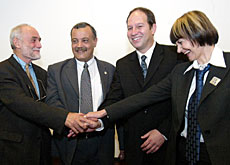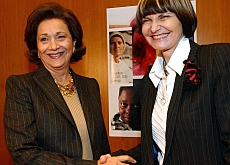Judgement day looms for new Red Cross symbol

Representatives from 192 countries are due in Geneva on Monday for a conference to decide whether to adopt a new emblem for the Red Cross movement.
The two-day meeting is the result of tightrope diplomacy by Switzerland to resolve the long-standing issue of a third humanitarian symbol.
Approval of the so-called “red crystal” by the signatory states moved a step closer last week when the Israeli and Palestinian emergency services signed a groundbreaking cooperation agreement.
The accord, brokered by the Swiss foreign ministry, cleared the way for a deal on a new emblem in addition to the red cross and red crescent currently in use.
A successful outcome in Geneva would mark the end of months of delicate shuttle diplomacy by the Swiss to resolve what Foreign Minister Micheline Calmy-Rey described last week as a “century-old controversy”.
“Switzerland in its capacity as the depositary of the Geneva Conventions has done its best – and will continue to do so – in order to facilitate a harmonious and consensus-based solution to the emblem question,” foreign ministry spokesman Lars Knuchel told swissinfo.
“The diplomatic conference is the right time to achieve this long-term goal.”
Red crystal
Under the change, countries would be able to place their own symbols inside the red crystal, as long as they have been in use for some time.
This would open the door for Israel’s Magen David Adom (MDA) to finally join the International Red Cross and Red Crescent Movement after more than 50 years.
The Israeli emergency service refuses to use either of the two globally recognised symbols, opting instead for a red Star of David.
Arab countries have previously resisted any attempt to accommodate the Israelis within the international movement.
But last week’s recognition by Israel of the Palestine Red Crescent Society and the improved situation in the occupied territories has led to a softening of their stance.
Middle East
Calmy-Rey travelled to the Middle East in October to try to shore up support for the new emblem and mediate between the Palestinians and the Israelis.
A previous attempt by the Swiss in 2000 to resolve the issue of a third emblem foundered following the outbreak of the second Palestinian Intifada.
In the same year the American Red Cross stopped its contributions to the Geneva-based International Federation of Red Cross and Red Crescent Societies (IFRC) in protest at the continued isolation of MDA. This amounts to $35 million (SFr46 million) in lost revenue for the IFRC.
Devorah Goldberg, spokeswoman for the American Red Cross, said the organisation was unlikely to review its position until MDA had been granted membership.
Speaking ahead of the conference, the Swiss-run International Committee of the Red Cross (ICRC) said it was optimistic that the additional protocol to the Conventions, incorporating the red crystal, would be passed.
“This is very much a matter for the states, but from our perspective the signs have been positive since September,” ICRC spokesman Ian Piper told swissinfo. “But it’s not a done deal until it’s signed.”
Representatives from 123 countries participated in informal discussions in Geneva in September, paving the way for this week’s diplomatic conference.
swissinfo, Adam Beaumont in Geneva
The Swiss-run ICRC was founded in 1863.
It assists victims of war and armed violence.
The Geneva-based IFRC was founded in 1919.
It coordinates disaster relief by the national societies.
Together they form the International Red Cross and Red Crescent Movement.
The red cross emblem, which was officially approved in 1864, is based on the Swiss flag with the colours reversed.
The red crescent was adopted during the war between Russia and the Ottoman Empire (1876-1878). It is based on the Turkish flag, with the colours switched.
Some countries, such as Israel, have found it difficult to use either of the emblems. Hence the move to adopt an additional symbol that is free of any national, cultural, religious, political or ethnic connotations.

In compliance with the JTI standards
More: SWI swissinfo.ch certified by the Journalism Trust Initiative


You can find an overview of ongoing debates with our journalists here . Please join us!
If you want to start a conversation about a topic raised in this article or want to report factual errors, email us at english@swissinfo.ch.